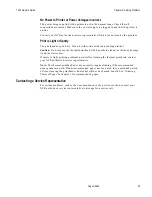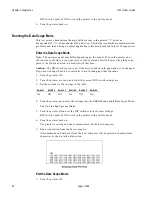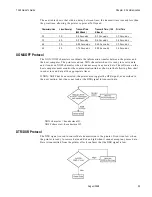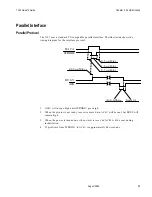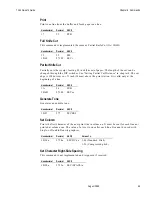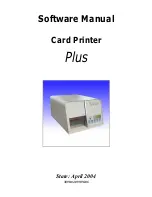
Chapter 5: Communication
7193 Owner’s Guide
August 1998
34
Using BASIC to Send Commands
In BASIC, printer commands are sent as a string of characters preceded by the LPRINT
command. For example,
LPRINT CHR$(&H0A)
sends the hexadecimal number 0A to the printer, which causes the printer to print the
contents of its print buffer. Previously sent commands tell the printer exactly how this data
should appear on the paper. For example,
LPRINT CHR$(&H12); "ABC"; CHR$(&H0A)
sends the hexadecimal numbers 12 41 42 43 0A to the printer. This causes the printer to set
itself to double wide mode (12), load the print buffer with “ABC” (41 42 43), and finally,
print (0A). Again, the communication link that the BASIC program outputs to must be
matched to that of the printer.
RS-232C Interface
The RS-232C interface uses either XON/XOFF or DTR/DSR protocol. For XON/XOFF, a
particular character is sent back and forth between the host and the printer to regulate the
communication. For DTR/DSR, changes in the DTR/DSR signal coordinate the
information flow.
The RS-232C version of the 7193 offers the standard options which are selected with the
DIP switches. See “RS-232C Switch Settings” later in this chapter for the switch settings.
Print Speed and Timing
The faster speed of new 7193 models requires the application to send data to the printer at
least as fast as it is printed. The application must also allow receipt lines to be buffered
ahead at the printer, so the printer will be able to print each line immediately after the
preceding line, without stopping to wait for more data. Ideally, the application will send
all the data for an entire receipt without pausing between characters or lines transmitted.
If the application sends data at 9600 baud and pauses between lines for as short a time as
50 milliseconds, the printer will never be able to print at full speed. However, if the
application sends data at 19.2 K baud and does not pause between lines, the printer will be
able to print at its full speed of 1020 lines/minute.
The table shows that with a pause of 50 milliseconds after each line, the transmit time
equals or exceeds the print time, slowing down the printer, regardless of the baud rate.
Characters/Line
Lines/Receipt
Transmit Time:
(9600 Baud)
Transmit Time:
(19.2 K Baud)
Print Time
20
20
1.4 Seconds
1.2 Seconds
1.2 Seconds
20
40
2.8 Seconds
2.4 Seconds
2.4 Seconds
44
20
1.88 Seconds
1.44 Seconds
1.2 Seconds
44
40
3.76 Seconds
2.88 Seconds
2.4 Seconds
Summary of Contents for 7193
Page 1: ...BD20 1439 A Issue B August 1998 NCR 7193 Thermal Receipt Printer Owner s Guide ...
Page 6: ...Contents 7193 Owner s Guide August 1998 x ...
Page 16: ...Chapter 2 Setting Up the Printer 7193 Owner s Guide August 1998 10 Parallel Models ...
Page 22: ...Chapter 2 Setting Up the Printer 7193 Owner s Guide August 1998 16 ...
Page 24: ...Chapter 2 Setting Up the Printer 7193 Owner s Guide August 1998 18 ...
Page 26: ...Chapter 2 Setting Up the Printer 7193 Owner s Guide August 1998 20 ...
Page 30: ...Chapter 3 Solving Problems 7193 Owner s Guide August 1998 24 ...
Page 48: ...Chapter 5 Communication 7193 Owner s Guide August 1998 42 ...
Page 88: ...Chapter 6 Commands 7193 Owner s Guide August 1998 82 ...
Page 96: ...Appendix B Print Characteristics 7193 Owner s Guide August 1998 88 ...
Page 102: ...Index 7193 Owner s Guide August 1998 94 ...
Page 103: ......




